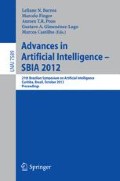Abstract
During the last 5 years, research on Human Activity Recognition (HAR) has reported on systems showing good overall recognition performance. As a consequence, HAR has been considered as a potential technology for e-health systems. Here, we propose a machine learning based HAR classifier. We also provide a full experimental description that contains the HAR wearable devices setup and a public domain dataset comprising 165,633 samples. We consider 5 activity classes, gathered from 4 subjects wearing accelerometers mounted on their waist, left thigh, right arm, and right ankle. As basic input features to our classifier we use 12 attributes derived from a time window of 150ms. Finally, the classifier uses a committee AdaBoost that combines ten Decision Trees. The observed classifier accuracy is 99.4%.
Access this chapter
Tax calculation will be finalised at checkout
Purchases are for personal use only
Preview
Unable to display preview. Download preview PDF.
References
Yu-Jin, H., Ig-Jae, K., Sang Chul, A., Hyoung-Gon, K.: Activity Recognition Using Wearable Sensors for Elder Care. In: Proceedings of Second International Conference on Future Generation Communication and Networking, FGCN 2008, vol. 2, pp. 302–305 (2008), doi:10.1109/FGCN.2008.165
Gjoreski, H., Lustrek, M., Gams, M.: Accelerometer Placement for Posture Recognition and Fall Detection. In: 7th International Conference on Intelligent Environments, IE (2011)
Lei, G., Bourke, A.K., Nelson, J.: A system for activity recognition using multi-sensor fusion. In: Annual International Conference of the IEEE Engineering in Medicine and Biology Society, EMBC (2011)
Salzberg, S.L.: C4.5: Programs for Machine Learning by J. Ross Quinlan. Morgan Kaufmann Publishers, Inc. (1993) Machine Learning 16(3), 235–240 (1994) ISSN: 0885-6125, doi: 10.1007/bf00993309
Freund, Y., Schapire, R.E.: Experiments with a New Boosting Algorithm. In: International Conference on Machine Learning, pp. 148–156 (1996)
Liu, S., Gao, R.X., John, D., Staudenmayer, J.W., Freedson, P.S.: Multisensor Data Fusion for Physical Activity Assessment. IEEE Transactions on Biomedical Engineering 59(3), 687–696 (2012) ISSN: 0018-9294
Yuting, Z., Markovic, S., Sapir, I., Wagenaar, R.C., Little, T.D.C.: Continuous functional activity monitoring based on wearable tri-axial accelerometer and gyroscope. In: 5th International Conference on Pervasive Computing Technologies for Healthcare, PervasiveHealth (2011)
Sazonov, E.S., et al.: Monitoring of Posture Allocations and Activities by a Shoe-Based Wearable Sensor. IEEE Transactions on Biomedical Engineering 58(4), 983–990 (2011)
Reiss, A., Stricker, D.: Introducing a modular activity monitoring system. In: Annual International Conference of the IEEE Engineering in Medicine and Biology Society, EMBC (2011)
Min, X., Goldfain, A., Chowdhury, A.R., DelloStritto, J.: Towards accelerometry based static posture identification. In: IEEE Consumer Communications and Networking Conference, CCNC (2011)
Maekawa, T., Watanabe, S.: Unsupervised Activity Recognition with User’s Physical Characteristics Data. In: 15th Annual International Symposium on Wearable Computers, ISWC (2011)
Martin, H., Bernardos, A.M., Tarrio, P., Casar, J.R.: Enhancing activity recognition by fusing inertial and biometric information. In: Proceedings of the 14th International Conference on Information Fusion, FUSION (2011)
Alvarez-Alvarez, A., Trivino, G., Cordon, O.: Body posture recognition by means of a genetic fuzzy finite state machine. In: IEEE 5th International Workshop on Genetic and Evolutionary Fuzzy Systems, GEFS (2011)
Jun-Ki, M., Sung-Bae, C.: Activity recognition based on wearable sensors using selection/fusion hybrid ensemble. In: IEEE International Conference on Systems, Man, and Cybernetics, SMC (2011)
Ioana-Iuliana, F., Rodica-Elena, D.: Detection of daily movements from data collected with two tri-axial accelerometers. In: 34th International Conference on Telecommunications and Signal Processing, TSP (2011)
Feng, W., Meiling, W., Nan, F.: Research on Classification of Human Daily Activities Based on a Single Tri-Axial Accelerometer. In: 1st International Workshop on Complexity and Data Mining, IWCDM (2011)
Czabke, A., Marsch, S., Lueth, T.C.: Accelerometer based real-time activity analysis on a microcontroller. In: 5th International Conference on Pervasive Computing Technologies for Healthcare, PervasiveHealth (2011)
Chernbumroong, S., Atkins, A.S., Hongnian, Y.: Activity classification using a single wrist-worn accelerometer. In: 5th International Conference on Software, Knowledge Information, Industrial Management and Applications, SKIMA (2011)
Bayati, H., Millan, J.d.R., Chavarriaga, R.: Unsupervised Adaptation to On-body Sensor Displacement in Acceleration-Based Activity Recognition. In: 15th Annual International Symposium on Wearable Computers, ISWC (2011)
Atallah, L., et al.: Sensor Positioning for Activity Recognition Using Wearable Accelerometers. IEEE Transactions on Biomedical Circuits and Systems 5(4), 320–329 (2011)
Andreu, J., Baruah, R.D., Angelov, P.: Real time recognition of human activities from wearable sensors by evolving classifiers. In: IEEE International Conference on Fuzzy Systems, FUZZ (2011)
Xu, S., Kashima, H., Tomioka, R., Ueda, N., Ping, L.: A New Multi-task Learning Method for Personalized Activity Recognition. In: IEEE 11th International Conference on Data Mining, ICDM (2011)
Yang, X., Lianwen, J.: A naturalistic 3D acceleration-based activity dataset & benchmark evaluations. In: IEEE International Conference on Systems Man and Cybernetics (SMC), pp. 4081–4085 (2010) ISSN: 1062-922X
Maziewski, P., Kupryjanow, A., Kaszuba, K., Czyzewski, A.: Accelerometer signal pre-processing influence on human activity recognition. In: Conference Proceedings of Signal Processing Algorithms, Architectures, Arrangements, and Applications (SPA), pp. 95–99 (2009) ISSN:978-83-62065-06-6
Hall, M.A.: Correlation-based Feature Subset Selection for Machine Learning. PhD thesis, Department of Computer Science, University of Waikato, Hamilton, New Zealand (April 1999)
Author information
Authors and Affiliations
Editor information
Editors and Affiliations
Rights and permissions
Copyright information
© 2012 Springer-Verlag Berlin Heidelberg
About this paper
Cite this paper
Ugulino, W., Cardador, D., Vega, K., Velloso, E., Milidiú, R., Fuks, H. (2012). Wearable Computing: Accelerometers’ Data Classification of Body Postures and Movements. In: Barros, L.N., Finger, M., Pozo, A.T., Gimenénez-Lugo, G.A., Castilho, M. (eds) Advances in Artificial Intelligence - SBIA 2012. SBIA 2012. Lecture Notes in Computer Science(), vol 7589. Springer, Berlin, Heidelberg. https://doi.org/10.1007/978-3-642-34459-6_6
Download citation
DOI: https://doi.org/10.1007/978-3-642-34459-6_6
Publisher Name: Springer, Berlin, Heidelberg
Print ISBN: 978-3-642-34458-9
Online ISBN: 978-3-642-34459-6
eBook Packages: Computer ScienceComputer Science (R0)

